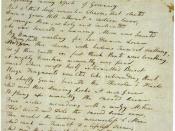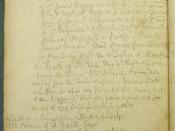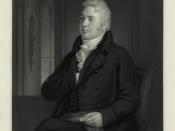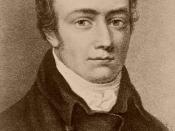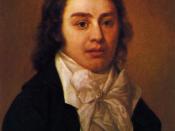ColeridgeÃÂs poem ÃÂThis Lime-Tree Bower My PrisonÃÂ teaches us that through an imaginative journey, you can broaden your mind and spirit. Imaginative journeys arenÃÂt bounded by physical barriers and obstacles. They allow the power of imagination to achieve mental, spiritual and emotional freedom. Coleridge communicates this idea through the use of the main characterÃÂs physical confinement under the bower tree. He is able to imagine his friendÃÂs journey through dell, plains, hills, meadows, sea and islands. This imaginative journey allows Coleridge to rise up above his physical restrictions and 'mentally walk alongside them'. Coleridge is able to change his initial perspective from seeing the Lime Tree Bower as a symbol of confinement and is able to move on to realize that the tree should be viewed as an object of great beauty and pleasure.
This poem was written in a conversational tone which frees Coleridge from restrictions such as rhyming and keeping a rhythm.
The poem begins on an inviting note with "well" being the first word. This contains an inviting sense of welcome and encourages the reader to feel comfortable and read on in order to join Coleridge on his journey. Coleridge uses a hyperbolic claim in the first verse "Friends, whom I may never see again", in order to communicate his initial sense of disappointment and frustration. This helps the audience identify with Coleridge and demonstrates the original negative outlook Coleridge possesses in relation to his physical confinement.
He exaggerates his confinement using ÃÂHad dimmed my eyes to blindness!ÃÂ which relates to darkness and the world shutting him out. The first scene in ColeridgeÃÂs imaginative journey is the ÃÂroaring dellÃÂ. Visual senses enhance the description of the scene ÃÂonly speckled by the mid-day sunÃÂ. The dell is a reflection of his current mood, unhealthy and isolated. ÃÂUnsunnÃÂd and damp, whose few poor yellow leaves neÃÂer tremble stillÃÂ draws the reader further into his journey. The ÃÂyellow leavesÃÂ suggests the plant is struggling to survive and possibly dying from the lack of sunlight.
As Coleridge moves on to focus on Charles, new colours are introduced to the image of countryside, purples, yellows and blues are added to the rainbow of endless positive imagery and with words such as "magnificent" the contrast between the country and the city is made evident. Coleridge describes the city in a negative light with the use of words such as "evil, pain and strange calamity". These words have negative meanings and further outline the defining differences evident between country and city. The country is presented through the idea of spiritual refreshment. Coleridge depicts the overwhelming feeling of the "swimming sense" so overcome by the beauty of it all, and as he gazes further into his dream we are able to see him forget all physical aspects. He uses powerful imagery "Colours cover the almightily spirit" to represent his imagination being so powerful it is on a separate level, almost communing with God. This technique allows us to see his spiritual refreshment raising him above others and expanding his spirit. His initial belief that the Lime Tree Bower was a symbol of confinement can be seen as one of God's great objects of nature that is so beautiful it can allow spiritual refreshment.
The personification of nature seen ÃÂthat Nature neÃÂer desertsÃÂ emphasises that nature can be found everywhere if you look for it. ÃÂNo plot so narrow, be but Nature there, no waste so vacant.ÃÂ The end of ColeridgeÃÂs imaginative journey is described using the symbol of the rook representing his old self, flying away into the distance. ÃÂits black wing now a dim speck, now vanishing in lightÃÂ . This final image shows his progress that he has made on this imaginative journey. The ÃÂblack wingÃÂ represents the dark thoughts such as anger and frustration he had before. The rook flying away is like a cleansing of his old self and a birth of a new person, one who sees the magnificence of nature.
Even though at the end of the poem, physically Coleridge has not changed, he is now seeing the world from a different perspective. This imaginative journey has brought him closer to his friends and taught him to appreciate nature.
Bibliography: Samuel Taylor Coleridge's Poem "This Lime-tree bower my Prison"
